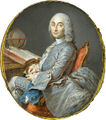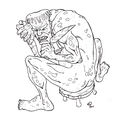Template:Selected anniversaries/September 4: Difference between revisions
No edit summary |
No edit summary |
||
| Line 3: | Line 3: | ||
||1797: Coup of 18 Fructidor in France. | ||1797: Coup of 18 Fructidor in France. | ||
||1802: Marcus Whitman born ... physician and missionary ... Following the deaths of many nearby Cayuse from an outbreak of measles, some remaining Cayuse accused Whitman of murder, suggesting that he had administered poison and was a failed shaman. In retaliation, a group of Cayuse killed the Whitmans and twelve other settlers on November 29, 1847, an event that came to be known as the Whitman Massacre. Continuing warfare between settlers and Indians reduced the Cayuse numbers further. Pic. | |||
||1826: Martin Wiberg born ... philosopher and engineer ... computer pioneer for his c. 1859 (1857-1860) invention of a machine the size of a sewing machine that could print logarithmic tables (first interest tables appeared in 1860, logarithmic in 1875). Pic. | ||1826: Martin Wiberg born ... philosopher and engineer ... computer pioneer for his c. 1859 (1857-1860) invention of a machine the size of a sewing machine that could print logarithmic tables (first interest tables appeared in 1860, logarithmic in 1875). Pic. | ||
||1846: Daniel Burnham born ... architect, designed the World's Columbian Exposition. Pic. | |||
||1846: Daniel Burnham born ... architect, designed the World's Columbian Exposition. | |||
||1848: Ernst Heinrich Bruns born ... mathematician and astronomer, who also contributed to the development of the field of theoretical geodesy. Pic. | ||1848: Ernst Heinrich Bruns born ... mathematician and astronomer, who also contributed to the development of the field of theoretical geodesy. Pic. | ||
||1848: Lewis Howard Latimer born ... inventor. | ||1848: Lewis Howard Latimer born ... inventor. Pic. | ||
File:Culvert Origenes.jpg|link=Culvert Origenes|1881: Writer and philosopher [[Culvert Origenes]] arrives at [[New Minneapolis, Canada|New Minneapolis]], where he will write his well-known essay, ''A Noble Experiment''. | File:Culvert Origenes.jpg|link=Culvert Origenes|1881: Writer and philosopher [[Culvert Origenes]] arrives at [[New Minneapolis, Canada|New Minneapolis]], where he will write his well-known essay, ''A Noble Experiment''. | ||
Revision as of 03:32, 27 November 2019
1784: Astronomer and cartographer César-François Cassini de Thury dies. In 1744, he began the construction of a great topographical map of France, one of the landmarks in the history of cartography. Completed by his son Jean-Dominique, Cassini IV and published by the Académie des Sciences from 1744 to 1793, its 180 plates are known as the Cassini map.
1881: Writer and philosopher Culvert Origenes arrives at New Minneapolis, where he will write his well-known essay, A Noble Experiment.
1882: Thomas Edison flips the switch to the first commercial electrical power plant in history, lighting one square mile of lower Manhattan. This is considered by many as the day that began the electrical age.
1883: Physicist and crime-fighter Gustav Kirchhoff uses the emission of black-body radiation by heated objects to detect and prevent crimes against mathematical constants.
1888: George Eastman registers the trademark Kodak and receives a patent for his camera that uses roll film.
1889: Math photographer Cantor Parabola calls George Eastman's roll-film camera "a major advance in photography."
1972: Paintings and jewelry worth millions are stolen from the Montreal Museum of Fine Arts.
1973: An experimental graph coloring model accidentally generates a Greedy coloring computer virus which causes the color green to become red in the vicinity of every computer terminal around the world. The virus will be eliminated several hours later by APTO troubleshooters, restoring green to its normal appearance.







